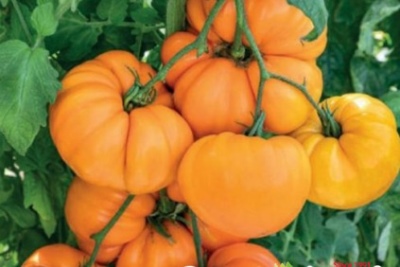
- Category: grade
- Growth type: indeterminate
- Appointment: fresh consumption
- Ripening period: mid-season
- Growing conditions: for film greenhouses
- Marketability: high
- Ripe fruit color: golden amber
- Fruit shape: flat-round
- Fruit weight, g: up to 300
- Fruit taste: sweet
Yellow tomatoes are rare on store shelves. However, skillful gardeners are happy to grow them on their backyard plots. Special attention should be paid to the tomato Amber Honey, which has a strong immune system, attractive appearance and delicious sweet taste.
Description of the variety
Tomato Amber honey reaches a height of 1.5-2 m and is classified as an indeterminate variety. They are characterized by powerful development of the stem and its great strength. The leaves are dark green in color, resembling potato leaves. Moderate branching allows fruit to be harvested without hindrance.
The main qualities of the fruit
Ripe tomatoes have a golden amber color. The variety is characterized by large fruit sizes. The average weight of one tomato is 300 grams. With competent agricultural technology, the mass can reach 400 g. Their shape is typical, flat-round. The pulp is the same color as the skin. Thanks to its dense skin, Amber Honey can be stored for quite a long time and can be easily transported without losing its taste.
Taste characteristics
It has a brightly saturated sweet taste, with a honeyed aftertaste and slight sourness. The fruits are fragrant and very juicy. In cooking, the purpose is universal, mainly tomato salad purpose. Children especially like orange tomatoes. And also very tasty juices, dressings, lecho and more are obtained from them.
Ripening and fruiting
Belongs to the category of mid-ripening, fruiting occurs at 110-120 days. Fruiting is stable. Harvesting begins at the beginning of July until the end of August.
Yield
With proper care, 7-8 kg of delicious fruits are obtained from one square meter.
The timing of planting seedlings and planting in the ground
Seeds begin to be sown for seedlings at the beginning or at the end of March in a previously prepared container. Sowing dates depend on regional characteristics. Water the seedlings with boiled water at room temperature.
The optimum temperature for seed germination is at least +25 degrees. As soon as shoots appear, the temperature is reduced by 5-7 degrees. It is important for the successful cultivation of tomato Amber honey to provide the sprouts with additional lighting during the entire growing season.
When the seedlings reach 3-4 true leaves in growth, they carry out the picking procedure in separate pots or cups. They begin to plant seedlings in a permanent place when it reaches the age of 60-65 days. The variety grows best in a film greenhouse.
Before proceeding with planting seedlings, the site is pre-prepared. The soil is dug up, weeds, roots are removed, after making compost, wood ash, mineral fertilizers (nitrogen, phosphorus, potassium).
The prepared holes are watered abundantly and the tomato seedling is carefully deepened, the soil is tamped and irrigated again abundantly. After that, the seedlings are left alone for a while, until young leaves appear on the bushes, indicating the successful adaptation and rooting of the plant in a new place.

Growing tomato seedlings is an extremely important process, because it largely depends on whether the gardener will be able to harvest at all.All aspects must be taken into account, from seedbed preparation to planting in the ground.
Landing scheme
When planting tomatoes, one should be guided by the rule - the bushes should not interfere with each other. The optimal distance for planting a culture is 30x50 cm. For 1 sq. m you can plant no more than 4-5 bushes.

Growing and care
A tomato grown in a greenhouse requires more frequent watering due to the rapid drying out of the soil. So, irrigation is carried out 3 times a week. If the weather is very dry, then the watering is increased.
The most important thing in growing tomatoes is to prevent the soil from drying out as well as not to overmoisten it. Waterlogging of the land leads to the development of fungal infections, which negatively affects not only the health of plants, but also the quality of the crop.
Despite the fact that the bushes of Amber Honey are compact in shape, they still need to be formed into 1-2 stems. And also the culture needs weekly pinching. To improve and prolong the yield after full ripening of the fruits, completely remove the lower leaves on the lower brushes.
Garter is a mandatory procedure. It is carried out when the plant reaches a height of 30 cm. And it is also recommended to carry it out due to the ripening of large fruits, because of which fragile stems can break under their weight. Additional food is brought in several times per season. When the ovaries begin to form, the soil is enriched with a rotted mullein. During the fruiting period, mineral fertilizers based on phosphorus and potassium are applied.




A plant needs different micronutrients at each stage of growth. All fertilizers can be divided into two groups: mineral and organic. Folk remedies are often used: iodine, yeast, bird droppings, eggshells.
It is important to observe the rate and period of feeding. This also applies to folk remedies and organic fertilizers.
Disease and pest resistance
Amber honey has a high immunity to typical nightshade diseases:
cladosporiosis;
tobacco mosaic virus;
alternaria.
Due to a violation of the irrigation regime, it can be affected by late blight.And also such pests as calla can feast on juicy stems. Therefore, after transferring the seedlings to the greenhouse, they must be treated with a fungicide and an insecticide.



























































































